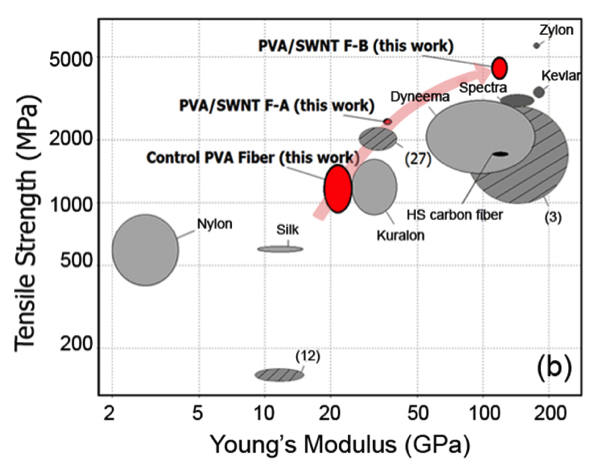Marilyn Minus, an assistant professor of engineering at Northeastern, has developed a type of carbon nanotube based polymer fiber that is stronger than the first kevlar, spectra and—even in its first generation—closely approaches the strength of the fourth (Zylon). It’s the crystallization process that drives the remarkable properties recently reported. In their research, Minus and her colleagues showed that they could easily turn these properties on or off. By changing nothing but the pattern of heating and cooling the material, they were able to increase the strength and toughness of fibers made with the very same ingredients. In the current research, Minus and her colleagues worked out the recipe and process for one particular polymer: polyvinyl alcohol. “But we can do this with other polymers and we are doing it,” she said.
From carbon black powder to metallic particles, a variety of materials can guide the formation of specific crystal types in a process called nucleation. But before carbon nanotubes, Minus said, “we’ve never had a nucleating material so similar to polymers.” This similarity allows the nanotubes to act likes skates along which the long polymer chains can slide, perfectly aligning themselves with one another.
Minus will now work out (with DARPA funding) the method for a polymer called polyacrylonitrle, or PAN. This is the dominant material used to form carbon fibers, which are of particular interest in lightweight composite materials such as those used in the Boeing 787 airliner. With the more organized structure afforded by Minus’ method, this material could see a vast increase in its already great performance.
ABSTRACT – PVA/single-walled nanotube (SWNT) composite fibers are fabricated using a steady shear-flow gel-spinning method. The resultant fibers show excellent tensile strength, modulus, and toughness of 4.9 GPa, 128 GPa, and 202 J · g−1, respectively. Templated interfacial crystallization of PVA in the vicinity of SWNT is controlled by tailoring the degree of undercooling of PVA during the composite solution preparation. WAXD shows that the templated crystallization behavior of the PVA at the SWNT interfacial region is new. PVA/SWNT fibers that exhibit interfacial structure show a predominant crystallization plane of (001) as compared to the (101) plane seen in PVA/SWNT fibers without a distinct interfacial structure. This demonstrates that the PVA interfacial region around SWNT has denser crystalline chain-packing.
If you liked this article, please give it a quick review on ycombinator or StumbleUpon. Thanks

Brian Wang is a Futurist Thought Leader and a popular Science blogger with 1 million readers per month. His blog Nextbigfuture.com is ranked #1 Science News Blog. It covers many disruptive technology and trends including Space, Robotics, Artificial Intelligence, Medicine, Anti-aging Biotechnology, and Nanotechnology.
Known for identifying cutting edge technologies, he is currently a Co-Founder of a startup and fundraiser for high potential early-stage companies. He is the Head of Research for Allocations for deep technology investments and an Angel Investor at Space Angels.
A frequent speaker at corporations, he has been a TEDx speaker, a Singularity University speaker and guest at numerous interviews for radio and podcasts. He is open to public speaking and advising engagements.



